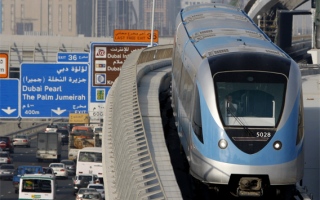Dubai Metro on track for record growth: 300 million users in 4 years
04:11AM Mon 9 Sep, 2013

On September 10, 2009, His Highness Sheikh Mohammed bin Rashid Al Maktoum, Vice-President and Prime Minister of the UAE and Ruler of Dubai, inaugurated Dubai's first Metro line. It served ten stations and transported just over a million commuters that month.
Today, four years later, Dubai Metro serves two lines, 46 stations and the number of commuters is increasing continuously, crossing the 300 million mark as of last month. By the end-August this year, Dubai Metro had served 312, 097, 588 commuters on both the Red Line and the Green Line, the Road and Transport Authority (RTA) told Emirates 24|7.
This means that in 2013 alone the total number of passengers, since its inception, jumped by almost 50 per cent compared to end-November in 2012, when 213,354 passengers were counted.
Metro commuters are continuously rising. The number of people who used the Metro this August hit 10.5 million, up from 8 million in the same month last year.
A lot has changed since September 10, 2009, the biggest advancement probably being the opening of the Green Line. Only one year after the opening of the Red Line, 18 stations on the Green Line were opened all at once on September 10, 2011.
In its first month the Green Line accounted for the transportation of 1.3 million passengers, a fast-growing commuters base which hit the 4 million bar twice – in March and May this year.
The Green Line contributed to a significant increase to the use of Metro overall. One month after its opening, the number of users on the Red Line had increased from 4.7 million per month to 5.5 million per month. The total number of passengers per month increased by 34 per cent.
The Red Line has not remained the same either. Starting as a route from Al Rashidiya to Nakheel Harbour and Tower, mostly serving the popular metro destinations around Deira and Bur Dubai, 18 Metro stations have been added since, with the latest addition being Danube in December last year.
Ceremonial was the opening of Burj Khalifa/Dubai Mall metro station, which was inaugurated simultaneously with the opening of Burj Khalifa on January 4, 2010.
Nearly two years later, a 820-metre temperature-controlled footbridge was opened to connect the popular Metro station into Dubai Mall. One month later, the number of passengers at Burj Khalifa/Dubai Mall Metro station had surged by one-fourth; from 440,000 passengers to 550,000.
Most popular stations from the opening of Dubai Metro have remained the Burjuman Metro station (previously Khalid bin Walid) and Union Metro station, where passengers can connect to the Green Line.
Although Burjuman station was titled the busiest station in the first 9 months after the opening of the Red Line, Union Metro station took over in June 2010, and has remained the most popular station since.
From the opening of the Red Line in September 2010 until last month, Union Metro station served 20.3 million passengers. Burjuman station followed closely with 19.7 million passengers overall.
Unlike the Red Line, the two connecting metro stations on the Green Line have proven to be less popular, with Al Fahidi Metro station topping as the busiest stop, followed by Baniyas Square metro station.
From the opening of the Green Line in September 2011 until last month, Al Fahidi Metro station served 9.4 million passengers, while Baniyas Square saw a total of 9 million commuters.
The future for the rail network are promising, with plans to increase the rate of trips made by public transit means to 30 per cent by 2030.
On the Red Line Energy metro station is yet to become operational, and the Green Line hosts two Metro stations that are closed till date – Al Jadaf and Creek.
With a rail network of 74.6km long Dubai currently houses the longest driverless rail network in the world.
This number will increase over the coming years, as plans have been announced to expand the network with three additional metro lines, in addition to an extension of the Red and Green Lines.
Before the end of 2020, an extension of the Green Line will connect Academic City to Al Jadaf metro station. Recent reports suggested that a connection from Al Rashidiya metro station to Mirdif will be materialised within the same time frame.
A new rail network will connect remote areas by metro. A Purple Line will run parallel to Emirates Road, while a Blue Line will run parallel to Dubai Bypass Road. A Gold Line will provide two entrees deep into Dubai Land, to locations which were previously only accessible by personal transportation.
In addition to the connectivity between metro lines, Dubai metro will provide access to future rail networks such as Etihad Rail and al Sufouh Tram.
Three proposed stations — Al Maktoum Airport Station, Dubai Land Station and the Central Station — have been announced to provide access to the anticipated Etihad Rail network, which will run to Oman and Saudi Arabia.
Emirates24/7













